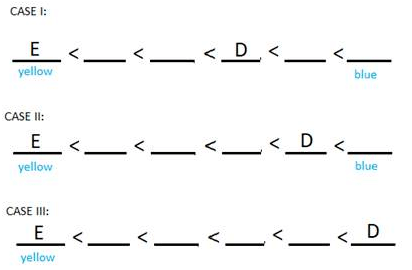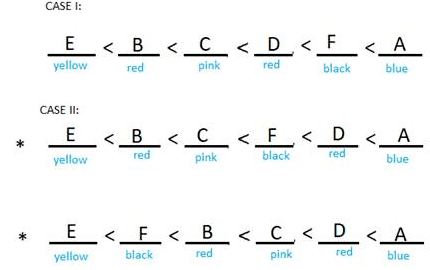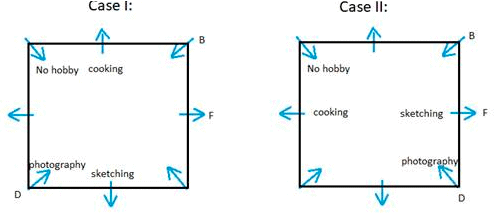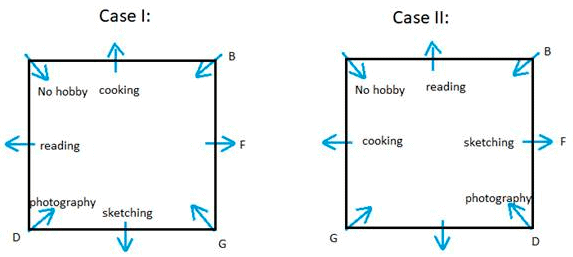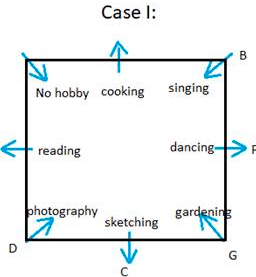MAH-CET MBA Mock Test- 9 - CAT MCQ
30 Questions MCQ Test - MAH-CET MBA Mock Test- 9
Directions : Study the following information carefully and answer the given questions:
The following is an illustration of an input and the rearrangement. (All the numbers are two digits numbers)
Input: 76 mute 29 available violet 24 dish
Step 1: dish mute 29 available violet 24 76
Step 2: dish mute available violet 24 29 76
Step 3: dish mute violet available 24 29 76
Step 4: dish mute violet available 08 18 42
Step 4 is the final step of the given input
Now study the above arrangement and arrange the input given below as per the arrangement.
INPUT: 13 23 greater error ask 36 45 education weakening.
Which of the following element will be 3rd to the right of the 2nd element from the left end in the penultimate step of the arrangement?
The words are arranged as per the number of vowels i.e. the word with lowest number of vowel is the leftmost word and so on. The numbers are arranged in descending order from right to left. The arrangement of words and numbers take place simultaneously. In the last step the digits of the number are multiplied, and the product is written in 2-digit format.
INPUT: 13 23 greater error ask 36 45 education weakening
Step 1: ask 13 23 greater error 36 education weakening 45
Step 2: ask error 13 23 greater education weakening 36 45
Step 3: ask error greater 13 education weakening 23 36 45
Step 4: ask error greater weakening education 13 23 36 45
Step 5: ask error greater weakening education 03 06 18 20
Step 3: ask error greater 13 education weakening 23 36 45
Which of the following will be the element that is 2nd to the right of the element that comes 5th from the right end in the second step?
Direction: Study the following information carefully and answer the given questions:
The following is an illustration of an input and the rearrangement. (All the numbers are two digits numbers)
Input: 76 mute 29 available violet 24 dish
Step 1: dish mute 29 available violet 24 76
Step 2: dish mute available violet 24 29 76
Step 3: dish mute violet available 24 29 76
Step 4: dish mute violet available 08 18 42
Step 4 is the final step of the given input
Now study the above arrangement and arrange the input given below as per the arrangement.
INPUT: 13 23 greater error ask 36 45 education weakening.
Which of the following element will come to the immediate right of 13 in the last but one step of the arrangement?
Direction: Study the following information carefully and answer the given questions:
The following is an illustration of an input and the rearrangement. (All the numbers are two digits numbers)
Input: 76 mute 29 available violet 24 dish
Step 1: dish mute 29 available violet 24 76
Step 2: dish mute available violet 24 29 76
Step 3: dish mute violet available 24 29 76
Step 4: dish mute violet available 08 18 42
Step 4 is the final step of the given input
Now study the above arrangement and arrange the input given below as per the arrangement.
INPUT: 13 23 greater error ask 36 45 education weakening.
Which of the following element comes exactly in between (neighbouring) 'greater' and '13' in step 2 of the arrangement?
Direction: In each of the following questions, two rows of numbers are given.
The resultant number in each row is to be worked out separately based on the following rules and the questions below the rows of numbers are to be answered. The operations of numbers progress from the left to the right.
Rules:
(i) If an odd number is followed by another composite odd number, they are to be added.
(ii) If an even number is followed by an odd number they are to be added.
(iii) If an even number is followed by a number which is the perfect square, the even number is to be subtracted from the perfect square.
(iv) If an odd number is followed by a prime odd number, the first number is to be divided by the second number.
(v) If an odd number is followed by an even number the second one is to be subtracted from the first number.
I. 15 8 21
II. a 3 27
If ‘a’ is the resultant of the first row, what will be the resultant of the second row?
Direction: In each question below, a statement is given, followed by two conclusions numbered I & II. You have to assume everything in the statement to be true, then consider the two conclusions together and decide which of them logically follows beyond a reasonable doubt from the information given in the statement.
Statement: The President of XYZ party indicated that 25 independent Members of Legislative Assembly (MLA) are seriously considering various options of joining some political party. But in any case all of them collectively will join one party only.
Conclusions:
I. The 25 independent MLAs will join XYZ party in a short period of time.
II. The 25 independent MLAs will join some other political party in a short period of time.
Direction: In each question below, a statement is given, followed by two conclusions numbered I & II. You have to assume everything in the statement to be true, then consider the two conclusions together and decide which of them logically follows beyond a reasonable doubt from the information given in the statement.
Statement: The ‘Official Secrets Act’ (OSA) enacted by the XYZ government during the war seems to be the source of much corruption in the country ‘P’.
Conclusions:
I. The Official Secrets Act has to be abolished immediately to stop corruption in country ‘P’.
II. The XYZ government wanted to encourage corruption in the government offices.
Direction: In making decisions about important questions, it is desirable to be able to distinguish between “strong” arguments and “weak” arguments in so far as they relate to the question. “Weak” arguments are those which are of minor importance and also may not be directly related to the question or may be related to a trivial aspect of the question. In each question below, is given a statement followed by two arguments numbered I and II. You have to decide which of the arguments is/are a ‘strong’ argument and which is/are a ‘weak’ argument.
Statement: Should seniority be the only criterion for the promotion?
Arguments:
I. No. All the senior employees are not interested in promotion.
II. Yes. Otherwise senior employees feel humiliated.
Direction: In each of the question given below, there are two statements followed by two conclusions numbered 1 and 2. You have to take the given statements to be true even if they seem to be at variance with commonly known facts and then decide which of the given conclusions logically follow(s) from the given statements.
Statements: Some pearls are jewels. Some jewels are ornaments.
Conclusions:
1. Some jewels are pearls.
2. Some ornaments are jewels.
Direction: In each of the question given below, there are two statements followed by two conclusions numbered 1 and 2. You have to take the given statements to be true even if they seem to be at variance with commonly known facts and then decide which of the given conclusions logically follow(s) from the given statements.
Statements: Some hens are cows. All the cows are horses.
Conclusions:-
1. Some horses are hens.
2. Some hens are horses.
Direction: In each of the question given below, there are two statements followed by two conclusions numbered 1 and 2. You have to take the given statements to be true even if they seem to be at variance with commonly known facts and then decide which of the given conclusions logically follow(s) from the given statements.
Statements: Some papers are pens. All the pencils are pens.
Conclusions:
1. Some pens are pencils.
2. Some pens are papers.
Direction: In each of the question given below, there are two statements followed by two conclusions numbered 1 and 2. You have to take the given statements to be true even if they seem to be at variance with commonly known facts and then decide which of the given conclusions logically follow(s) from the given statements.
Statements: All the actors are girls. All the girls are beautiful.
Conclusions:
1. All the actors are beautiful.
2. Some girls are actors.
These questions consist of two quantities, one in Column A and another in Column B. Compare the two quantities.
[(256 × 1024) P] / (500 + 12) = 2

These questions consist of two quantities, one in Column A and another in Column B. Compare the two quantities.
The equation of a line is 4x + 3y = 12

These questions consist of two quantities, one in Column A and another in Column B. Compare the two quantities.
A circle is inscribed in a square whose co-ordinates are (2,2),(2,5),(5,5) and (5,2). Another circle is circumscribed on the same square.

Directions : Study the following information carefully and answer the given questions:
The following is an illustration of an input and the rearrangement. (All the numbers are two digits numbers)
Input: 76 mute 29 available violet 24 dish
Step 1: dish mute 29 available violet 24 76
Step 2: dish mute available violet 24 29 76
Step 3: dish mute violet available 24 29 76
Step 4: dish mute violet available 08 18 42
Step 4 is the final step of the given input
Now study the above arrangement and arrange the input given below as per the arrangement.
INPUT: 13 23 greater error ask 36 45 education weakening.
How many steps will be required to arrange the given input?
Directions : Study the following information carefully and answer the given questions:
The following is an illustration of an input and the rearrangement. (All the numbers are two digits numbers)
Input: 76 mute 29 available violet 24 dish
Step 1: dish mute 29 available violet 24 76
Step 2: dish mute available violet 24 29 76
Step 3: dish mute violet available 24 29 76
Step 4: dish mute violet available 08 18 42
Step 4 is the final step of the given input
Now study the above arrangement and arrange the input given below as per the arrangement.
INPUT: 13 23 greater error ask 36 45 education weakening.
Which of the following will be the 3rd step of the arrangement?
Directions: There are six men - A, B, C, D, E and F having distinct ages, sitting from left to right in increasing order of their ages. Each except two wore shirts of different colours Red, pink, black, blue and yellow. Two persons wore one same colour.
E wore yellow shirt and is the youngest man and C is not the eldest.
D is elder than at least three people.
A, who was born before F and D, doesn't wears red shirt which is worn by two men and F wears black.
If F swaps position with the man to his immediate left, then the man wearing blue shirt becomes third to his right. (original arrangement is excluding swapping).
The men wearing yellow and blue shirt are sitting at maximum distance.
Red is worn by the man next to F and pink is worn by the man next to B.
C is younger than D and elder than B, who is younger than A and D.
Which two persons are wearing the same coloured shirt?
Directions: There are six men - A, B, C, D, E and F having distinct ages, sitting from left to right in increasing order of their ages. Each except two wore shirts of different colours Red, pink, black, blue and yellow. Two persons wore one same colour.
E wore yellow shirt and is the youngest man and C is not the eldest.
D is elder than at least three people.
A, who was born before F and D, doesn't wears red shirt which is worn by two men and F wears black.
If F swaps position with the man to his immediate left, then the man wearing blue shirt becomes third to his right. (original arrangement is excluding swapping).
The men wearing yellow and blue shirt are sitting at maximum distance.
Red is worn by the man next to F and pink is worn by the man next to B.
C is younger than D and elder than B, who is younger than A and D.
Who sits second to the left of the person who is fourth from the left?
Directions: There are six men - A, B, C, D, E and F having distinct ages, sitting from left to right in increasing order of their ages. Each except two wore shirts of different colours Red, pink, black, blue and yellow. Two persons wore one same colour.
E wore yellow shirt and is the youngest man and C is not the eldest.
D is elder than at least three people.
A, who was born before F and D, doesn't wears red shirt which is worn by two men and F wears black.
If F swaps position with the man to his immediate left, then the man wearing blue shirt becomes third to his right. (original arrangement is excluding swapping).
The men wearing yellow and blue shirt are sitting at maximum distance.
Red is worn by the man next to F and pink is worn by the man next to B.
C is younger than D and elder than B, who is younger than A and D.
How many men are elder than E but younger than C?
Directions: There are six men - A, B, C, D, E and F having distinct ages, sitting from left to right in increasing order of their ages. Each except two wore shirts of different colours Red, pink, black, blue and yellow. Two persons wore one same colour.
E wore yellow shirt and is the youngest man and C is not the eldest.
D is elder than at least three people.
A, who was born before F and D, doesn't wears red shirt which is worn by two men and F wears black.
If F swaps position with the man to his immediate left, then the man wearing blue shirt becomes third to his right. (original arrangement is excluding swapping).
The men wearing yellow and blue shirt are sitting at maximum distance.
Red is worn by the man next to F and pink is worn by the man next to B.
C is younger than D and elder than B, who is younger than A and D.
Who among the following is sitting between F and B.
Directions: There are six men - A, B, C, D, E and F having distinct ages, sitting from left to right in increasing order of their ages. Each except two wore shirts of different colours Red, pink, black, blue and yellow. Two persons wore one same colour.
E wore yellow shirt and is the youngest man and C is not the eldest.
D is elder than at least three people.
A, who was born before F and D, doesn't wears red shirt which is worn by two men and F wears black.
If F swaps position with the man to his immediate left, then the man wearing blue shirt becomes third to his right. (original arrangement is excluding swapping).
The men wearing yellow and blue shirt are sitting at maximum distance.
Red is worn by the man next to F and pink is worn by the man next to B.
C is younger than D and elder than B, who is younger than A and D.
If age of F and A is 34 years and 40 years respectively, what can be the possible age of D from the following options.
Directions: Eight students A, B, C, D, E, F, G and H who study in same class, went to the terrace of their school which is square in shape and four of them stood at the corners of the terrace facing towards the center of the terrace and of the remaining four, each stood at the center of each side of the terrace facing outside.
Seven of them have a different hobby out of Singing, Sketching, Dancing, gardening, reading, cooking and photography not necessarily in same order and one of them has no hobby.
G and D are standing neighbouring to C who is second to the right of the person who likes dancing.
One with no hobby who is not E or G, stands at one of the corners and is the neighbour of one who likes cooking who is facing away from the one who likes sketching (in same line of sight).
B is to the immediate left of F, who is neither at any corners nor is neighbouring the person with no hobbies. F doesn't likes reading.
B doesn't like gardening.
One who likes Sketching stands to immediate right of D who likes photography.
Person who likes reading is third to left of G, who doesn't likes cooking or sketching and sits at one of the corners.
A is not a person with no hobby and E doesn't like cooking.
Who has no hobby?
Directions: Eight students A, B, C, D, E, F, G and H who study in same class, went to the terrace of their school which is square in shape and four of them stood at the corners of the terrace facing towards the center of the terrace and of the remaining four, each stood at the center of each side of the terrace facing outside.
Seven of them have a different hobby out of Singing, Sketching, Dancing, gardening, reading, cooking and photography not necessarily in same order and one of them has no hobby.
G and D are standing neighbouring to C who is second to the right of the person who likes dancing.
One with no hobby who is not E or G, stands at one of the corners and is the neighbour of one who likes cooking who is facing away from the one who likes sketching (in same line of sight).
B is to the immediate left of F, who is neither at any corners nor is neighbouring the person with no hobbies. F doesn't likes reading.
B doesn't like gardening.
One who likes Sketching stands to immediate right of D who likes photography.
Person who likes reading is third to left of G, who doesn't likes cooking or sketching and sits at one of the corners.
A is not a person with no hobby and E doesn't like cooking.
Find the odd one out of the following
Directions: Eight students A, B, C, D, E, F, G and H who study in same class, went to the terrace of their school which is square in shape and four of them stood at the corners of the terrace facing towards the center of the terrace and of the remaining four, each stood at the center of each side of the terrace facing outside.
Seven of them have a different hobby out of Singing, Sketching, Dancing, gardening, reading, cooking and photography not necessarily in same order and one of them has no hobby.
G and D are standing neighbouring to C who is second to the right of the person who likes dancing.
One with no hobby who is not E or G, stands at one of the corners and is the neighbour of one who likes cooking who is facing away from the one who likes sketching (in same line of sight).
B is to the immediate left of F, who is neither at any corners nor is neighbouring the person with no hobbies. F doesn't likes reading.
B doesn't like gardening.
One who likes Sketching stands to immediate right of D who likes photography.
Person who likes reading is third to left of G, who doesn't likes cooking or sketching and sits at one of the corners.
A is not a person with no hobby and E doesn't like cooking.
Who among the following likes sketching as a hobby?
Directions: Eight students A, B, C, D, E, F, G and H who study in same class, went to the terrace of their school which is square in shape and four of them stood at the corners of the terrace facing towards the center of the terrace and of the remaining four, each stood at the center of each side of the terrace facing outside.
Seven of them have a different hobby out of Singing, Sketching, Dancing, gardening, reading, cooking and photography not necessarily in same order and one of them has no hobby.
G and D are standing neighbouring to C who is second to the right of the person who likes dancing.
One with no hobby who is not E or G, stands at one of the corners and is the neighbour of one who likes cooking who is facing away from the one who likes sketching (in same line of sight).
B is to the immediate left of F, who is neither at any corners nor is neighbouring the person with no hobbies. F doesn't likes reading.
B doesn't like gardening.
One who likes Sketching stands to immediate right of D who likes photography.
Person who likes reading is third to left of G, who doesn't likes cooking or sketching and sits at one of the corners.
A is not a person with no hobby and E doesn't like cooking.
Which of the given following pairs is standing diagonally opposite to each other?
Directions: Eight students A, B, C, D, E, F, G and H who study in same class, went to the terrace of their school which is square in shape and four of them stood at the corners of the terrace facing towards the center of the terrace and of the remaining four, each stood at the center of each side of the terrace facing outside.
Seven of them have a different hobby out of Singing, Sketching, Dancing, gardening, reading, cooking and photography not necessarily in same order and one of them has no hobby.
G and D are standing neighbouring to C who is second to the right of the person who likes dancing.
One with no hobby who is not E or G, stands at one of the corners and is the neighbour of one who likes cooking who is facing away from the one who likes sketching (in same line of sight).
B is to the immediate left of F, who is neither at any corners nor is neighbouring the person with no hobbies. F doesn't likes reading.
B doesn't like gardening.
One who likes Sketching stands to immediate right of D who likes photography.
Person who likes reading is third to left of G, who doesn't likes cooking or sketching and sits at one of the corners.
A is not a person with no hobby and E doesn't like cooking.
Where is the person who likes reading is standing with respect to the person who likes singing?
Directions: Six professors P, Q, R, S, T and U teach in Hansraj, Miranda, FMS, DTU, Stephen, LSR but not necessarily in the same order. They teach Science, Maths, Physics, Chemistry, Social Studies and Music not necessarily in the same order.
Each Professors teaches only one subject and teaches in only one college.
P, Q and R do not teach music.
R teaches in Hansraj.
The professor teaching in FMS teaches Social Studies and the professor teaching in Stephen teaches Science.
The professor teaching in LSR does not teach Chemistry.
T teaches in FMS and P teaches Science.
S teaches neither in DTU nor in LSR.
The professor teaching in DTU teaches music.
The professor teaching physics neither teach in LSR nor in Miranda.
In which college does P teaches?
Directions: Six professors P, Q, R, S, T and U teach in Hansraj, Miranda, FMS, DTU, Stephen, LSR but not necessarily in the same order. They teach Science, Maths, Physics, Chemistry, Social Studies and Music not necessarily in the same order.
Each Professors teaches only one subject and teaches in only one college.
P, Q and R do not teach music.
R teaches in Hansraj.
The professor teaching in FMS teaches Social Studies and the professor teaching in Stephen teaches Science.
The professor teaching in LSR does not teach Chemistry.
T teaches in FMS and P teaches Science.
S teaches neither in DTU nor in LSR.
The professor teaching in DTU teaches music.
The professor teaching physics neither teach in LSR nor in Miranda.
Who teaches in LSR?
Directions: Six professors P, Q, R, S, T and U teach in Hansraj, Miranda, FMS, DTU, Stephen, LSR but not necessarily in the same order. They teach Science, Maths, Physics, Chemistry, Social Studies and Music not necessarily in the same order.
Each Professors teaches only one subject and teaches in only one college.
P, Q and R do not teach music.
R teaches in Hansraj.
The professor teaching in FMS teaches Social Studies and the professor teaching in Stephen teaches Science.
The professor teaching in LSR does not teach Chemistry.
T teaches in FMS and P teaches Science.
S teaches neither in DTU nor in LSR.
The professor teaching in DTU teaches music.
The professor teaching physics neither teach in LSR nor in Miranda.
Which of the following is correctly matched?











